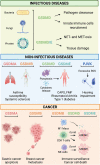Gasdermins: New Therapeutic Targets in Host Defense, Inflammatory Diseases, and Cancer
- PMID: 35844522
- PMCID: PMC9285118
- DOI: 10.3389/fimmu.2022.898298
Gasdermins: New Therapeutic Targets in Host Defense, Inflammatory Diseases, and Cancer
Abstract
Gasdermins (GSDMs) are a class of pore-forming proteins related to pyroptosis, a programmed cell death pathway that is induced by a range of inflammatory stimuli. Small-scale GSDM activation and pore formation allow the passive release of cytokines, such as IL-1β and IL-18, and alarmins, but, whenever numerous GSDM pores are assembled, osmotic lysis and cell death occur. Such GSDM-mediated pyroptosis promotes pathogen clearance and can help restore homeostasis, but recent studies have revealed that dysregulated pyroptosis is at the root of many inflammation-mediated disease conditions. Moreover, new homeostatic functions for gasdermins are beginning to be revealed. Here, we review the newly discovered mechanisms of GSDM activation and their prominent roles in host defense and human diseases associated with chronic inflammation. We also highlight the potential of targeting GSDMs as a new therapeutic approach to combat chronic inflammatory diseases and cancer and how we might overcome the current obstacles to realize this potential.
Keywords: cancer; gasdermins; host defense; inflammasome; pyroptosis; therapeutics.
Copyright © 2022 Magnani, Colantuoni and Mortellaro.
Conflict of interest statement
The authors declare that the research was conducted in the absence of any commercial or financial relationships that could be construed as a potential conflict of interest.
Figures


Similar articles
-
The Pyroptotic and Nonpyroptotic Roles of Gasdermins in Modulating Cancer Progression and Their Perspectives on Cancer Therapeutics.Arch Immunol Ther Exp (Warsz). 2023 May 31;71(1):14. doi: 10.1007/s00005-023-00678-9. Arch Immunol Ther Exp (Warsz). 2023. PMID: 37258998 Review.
-
Gasdermins gone wild: new roles for GSDMs in regulating cellular homeostasis.Trends Cell Biol. 2023 Sep;33(9):773-787. doi: 10.1016/j.tcb.2023.02.007. Epub 2023 Apr 14. Trends Cell Biol. 2023. PMID: 37062616 Free PMC article. Review.
-
To die or not to die: Gasdermins in intestinal health and disease.Semin Immunol. 2024 Feb;71:101865. doi: 10.1016/j.smim.2024.101865. Epub 2024 Jan 16. Semin Immunol. 2024. PMID: 38232665 Free PMC article. Review.
-
Epigenetic and transcriptional control of gasdermins.Semin Immunol. 2023 Nov;70:101841. doi: 10.1016/j.smim.2023.101841. Epub 2023 Sep 11. Semin Immunol. 2023. PMID: 37703611 Review.
-
Epithelial Pyroptosis in Host Defense.J Mol Biol. 2022 Feb 28;434(4):167278. doi: 10.1016/j.jmb.2021.167278. Epub 2021 Oct 8. J Mol Biol. 2022. PMID: 34627788 Free PMC article. Review.
Cited by
-
Icaritin Exerts Anti-Cancer Effects through Modulating Pyroptosis and Immune Activities in Hepatocellular Carcinoma.Biomedicines. 2024 Aug 21;12(8):1917. doi: 10.3390/biomedicines12081917. Biomedicines. 2024. PMID: 39200381 Free PMC article.
-
Anti-inflammatory interventions in coronary artery disease: antipodal responses requiring targeted therapeutic strategies.Basic Res Cardiol. 2025 Aug;120(4):597-618. doi: 10.1007/s00395-025-01121-0. Epub 2025 Jun 12. Basic Res Cardiol. 2025. PMID: 40504384 Review.
-
The role of the NLRP3 inflammasome and pyroptosis in cardiovascular diseases.Nat Rev Cardiol. 2024 Apr;21(4):219-237. doi: 10.1038/s41569-023-00946-3. Epub 2023 Nov 3. Nat Rev Cardiol. 2024. PMID: 37923829 Free PMC article. Review.
-
Iron Overload-induced Ferroptosis as a Target for Protection against Obliterative Bronchiolitis after Orthotopic Tracheal Transplantation in Mice.Curr Mol Med. 2025;25(6):746-759. doi: 10.2174/0115665240304363240524103203. Curr Mol Med. 2025. PMID: 38835130
-
Escherichia coli K88 activates NLRP3 inflammasome-mediated pyroptosis in vitro and in vivo.Biochem Biophys Rep. 2024 Feb 21;38:101665. doi: 10.1016/j.bbrep.2024.101665. eCollection 2024 Jul. Biochem Biophys Rep. 2024. PMID: 38419757 Free PMC article.
References
-
- Tamura M, Tanaka S, Fujii T, Aoki A, Komiyama H, Ezawa K, et al. . Members of a Novel Gene Family, Gsdm, are Expressed Exclusively in the Epithelium of the Skin and Gastrointestinal Tract in a Highly Tissue-Specific Manner. Genomics (2007) 89(5):618–29. doi: 10.1016/j.ygeno.2007.01.003 - DOI - PubMed
Publication types
MeSH terms
Substances
LinkOut - more resources
Full Text Sources
Medical
Miscellaneous

